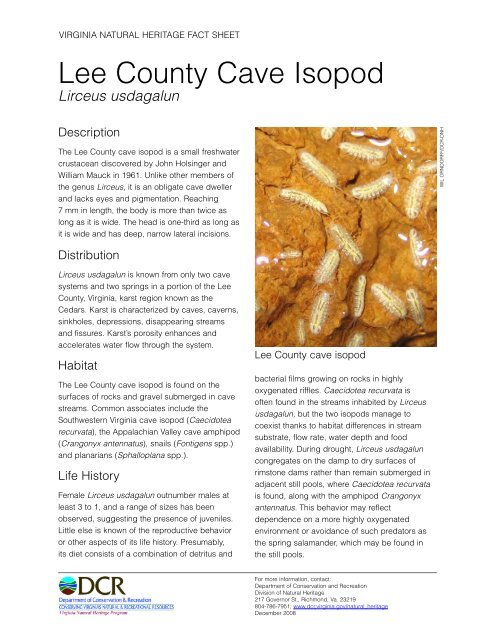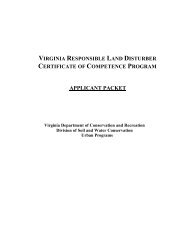Lee County Cave Isopod - Virginia Department of Conservation and ...
Lee County Cave Isopod - Virginia Department of Conservation and ...
Lee County Cave Isopod - Virginia Department of Conservation and ...
You also want an ePaper? Increase the reach of your titles
YUMPU automatically turns print PDFs into web optimized ePapers that Google loves.
VIRGINIA NATURAL HERITAGE FACT SHEET<br />
<strong>Lee</strong> <strong>County</strong> <strong>Cave</strong> <strong>Isopod</strong><br />
Lirceus usdagalun<br />
Description<br />
The <strong>Lee</strong> <strong>County</strong> cave isopod is a small freshwater<br />
crustacean discovered by John Holsinger <strong>and</strong><br />
William Mauck in 1961. Unlike other members <strong>of</strong><br />
the genus Lirceus, it is an obligate cave dweller<br />
<strong>and</strong> lacks eyes <strong>and</strong> pigmentation. Reaching<br />
7 mm in length, the body is more than twice as<br />
long as it is wide. The head is one-third as long as<br />
it is wide <strong>and</strong> has deep, narrow lateral incisions.<br />
Distribution<br />
Lirceus usdagalun is known from only two cave<br />
systems <strong>and</strong> two springs in a portion <strong>of</strong> the <strong>Lee</strong><br />
<strong>County</strong>, <strong>Virginia</strong>, karst region known as the<br />
Cedars. Karst is characterized by caves, caverns,<br />
sinkholes, depressions, disappearing streams<br />
<strong>and</strong> fissures. Karst’s porosity enhances <strong>and</strong><br />
accelerates water flow through the system.<br />
Habitat<br />
The <strong>Lee</strong> <strong>County</strong> cave isopod is found on the<br />
surfaces <strong>of</strong> rocks <strong>and</strong> gravel submerged in cave<br />
streams. Common associates include the<br />
Southwestern <strong>Virginia</strong> cave isopod (Caecidotea<br />
recurvata), the Appalachian Valley cave amphipod<br />
(Crangonyx antennatus), snails (Fontigens spp.)<br />
<strong>and</strong> planarians (Sphalloplana spp.).<br />
Life History<br />
Female Lirceus usdagalun outnumber males at<br />
least 3 to 1, <strong>and</strong> a range <strong>of</strong> sizes has been<br />
observed, suggesting the presence <strong>of</strong> juveniles.<br />
Little else is known <strong>of</strong> the reproductive behavior<br />
or other aspects <strong>of</strong> its life history. Presumably,<br />
its diet consists <strong>of</strong> a combination <strong>of</strong> detritus <strong>and</strong><br />
<strong>Lee</strong> <strong>County</strong> cave isopod<br />
bacterial films growing on rocks in highly<br />
oxygenated riffles. Caecidotea recurvata is<br />
<strong>of</strong>ten found in the streams inhabited by Lirceus<br />
usdagalun, but the two isopods manage to<br />
coexist thanks to habitat differences in stream<br />
substrate, flow rate, water depth <strong>and</strong> food<br />
availability. During drought, Lirceus usdagalun<br />
congregates on the damp to dry surfaces <strong>of</strong><br />
rimstone dams rather than remain submerged in<br />
adjacent still pools, where Caecidotea recurvata<br />
is found, along with the amphipod Crangonyx<br />
antennatus. This behavior may reflect<br />
dependence on a more highly oxygenated<br />
environment or avoidance <strong>of</strong> such predators as<br />
the spring salam<strong>and</strong>er, which may be found in<br />
the still pools.<br />
For more information, contact:<br />
<strong>Department</strong> <strong>of</strong> <strong>Conservation</strong> <strong>and</strong> Recreation<br />
Division <strong>of</strong> Natural Heritage<br />
217 Governor St., Richmond, Va. 23219<br />
804-786-7951; www.dcr.virginia.gov/natural_heritage<br />
December 2008<br />
WIL ORNDORFF/DCR-DNH
Threats <strong>and</strong> <strong>Conservation</strong><br />
In 1987, leachate from a sawmill heavily polluted<br />
the stream <strong>of</strong> one cave inhabited by the <strong>Lee</strong><br />
<strong>County</strong> cave isopod. The level <strong>of</strong> dissolved<br />
oxygen in that stream diminished to a point that<br />
all life in the stream was eliminated. By November<br />
2001, the fauna was making a notable recovery,<br />
<strong>and</strong> by February 2002, staff <strong>of</strong> the Division <strong>of</strong><br />
Natural Heritage <strong>of</strong> the <strong>Virginia</strong> <strong>Department</strong> <strong>of</strong><br />
<strong>Conservation</strong> <strong>and</strong> Recreation <strong>and</strong> <strong>of</strong> the U.S. Fish<br />
<strong>and</strong> Wildlife Service found that the isopod had<br />
recolonized that cave, possibly having taken<br />
refuge in uncontaminated reaches upstream<br />
following the 1987 incident.<br />
In addition to water quality degradation, threats<br />
to the isopod include the use <strong>of</strong> sinkholes as<br />
disposal sites for household, industrial <strong>and</strong><br />
agricultural wastes, nonpoint-source pollution,<br />
failing septic tanks, toxic spills, <strong>and</strong> improper<br />
development on or near key karst areas.<br />
In 1992, the <strong>Lee</strong> <strong>County</strong> cave isopod was listed<br />
as endangered. The species is considered both<br />
globally <strong>and</strong> state imperiled due to its extremely<br />
small range <strong>and</strong> small population.<br />
In 1997, a recovery plan was written to increase<br />
the viability <strong>of</strong> Lirceus usdagalun <strong>and</strong> eventually<br />
have it removed from the endangered species<br />
list. Numerous partnerships were developed to<br />
implement the plan.<br />
The Cedars, an area <strong>of</strong> more than 30 square<br />
miles, has been designated a Natural Area<br />
Preserve <strong>and</strong> is owned by the Division <strong>of</strong> Natural<br />
Heritage. The Cedars Natural Area Preserve is<br />
also a haven for many rare plant species.<br />
<strong>Virginia</strong> Natural Heritage<br />
The <strong>Virginia</strong> <strong>Department</strong> <strong>of</strong> <strong>Conservation</strong> <strong>and</strong><br />
Recreation’s Division <strong>of</strong> Natural Heritage<br />
maintains a database <strong>of</strong> rare species, populations<br />
<strong>and</strong> natural communities in the commonwealth,<br />
<strong>and</strong> manages the State natural Area Preserve<br />
System. Natural Heritage biologists, stewardship,<br />
<strong>and</strong> protection staff can answer l<strong>and</strong>owners’<br />
questions about rare species <strong>and</strong> sensitive<br />
habitats. The staff also provides information <strong>and</strong><br />
expertise on conservation <strong>and</strong> management<br />
practices that help ensure that we preserve our<br />
rich natural heritage <strong>and</strong> pass it on to future<br />
<strong>Virginia</strong>ns.<br />
To learn more about <strong>Virginia</strong>’s rare plant <strong>and</strong><br />
animal species <strong>and</strong> rich biological communities,<br />
visit the website <strong>of</strong> the Division <strong>of</strong> Natural Heritage,<br />
at www.dcr.virginia.gov/natural_heritage<br />
For additional information on the <strong>Lee</strong> <strong>County</strong> cave isopod,<br />
see NatureServe Explorer: Lirceus usdagalun<br />
Special thanks to the Riverine Chapter <strong>of</strong> the <strong>Virginia</strong><br />
Master Naturalist Program for its assistance in developing<br />
this fact sheet.
















